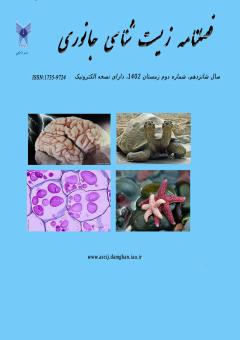مطالعه ماهیان بومی بنی و شیربت در مزارع پرورش ماهیان گرمابی استان خوزستان از نظر آلودگی به فلزات سنگین و ارزیابی خطر برای مصرف کنندگان
محورهای موضوعی : فصلنامه زیست شناسی جانوری
محمد حمزه پور
1
,
رضا سلیقه زاده
2
![]() ,
بهنام پدرام
3
,
بهنام پدرام
3
![]() ,
مرجان مسافر
4
,
مرجان مسافر
4
1 - گروه دامپزشکی، واحد شوشتر، دانشگاه آزاد اسلامی، شوشتر، ایران
2 - گروه دامپزشکی، واحد شوشتر، دانشگاه آزاد اسلامی، شوشتر، ایران
3 - گروه دامپزشکی، واحد شوشتر، دانشگاه آزاد اسلامی، شوشتر، ایران
4 - گروه بیولوژی دریا، واحد علوم و تحقیقات، دانشگاه آزاد اسلامی، تهران، ایران
کلید واژه: فلزات سنگین, بنی, شیربت, ارزیابی خطر, خوزستان,
چکیده مقاله :
فلزات سنگین به دلیل برخورداری از ماهیتی تخریب ناپذیر، زمینه ساز تهدیدی جدی برای سلامت آبزیان و همچنین انسانها در صورت تجمع یافتن سطح غلظت بالایی از آنها در بافت موجودات آبزی هستند. به همین منظور مطالعه حاضر با هدف بررسی ماهیان بومی بنی و شیربت در مزارع پرورش ماهیان گرمابی استان خوزستان از نظر آلودگی به فلزات سنگین و ارزیابی خطر برای مصرف کنندگان انجام پذیرفت. در مطالعه کنونی، سنجش غلظت سیزده عنصر (آرسنیک، کادمیوم، کبالت، کروم، مس، آهن، جیوه، منگنز، مولیبدن، نیکل، سرب، قلع و روی) در بافت عضله ماهیان بنی (Mesopotamichthys sharpeyi) و شیربت (Barbus grypus) صورت گرفت. نتایج مطالعه حاضر نشان داد که اختلاف معنیداری بین غلظت فلزات اندازه گیری شده در ماهیان بنی و شیربت وجود نداشت (05/0p >). یافتههای تحقیق نشانگر این بودند که فلزات آهن و آرسنیک به ترتیب دارای بیشترین و کمترین غلظت در بافت عضله ماهیان بنی و شیربت بودند. مقایسه مقادیر فلزات سنگین اندازه گیری شده با استانداردهای بهداشتی بینالمللی نشان داد که غلظت تمامی عناصر به جز سرب به طور معنیداری کمتر از حد مجاز بودند (05/0p >). غلظت سرب به طور معنیدارییشتر از حد مجاز بود (05/0p >). ارزیابی خطر بهداشتی نشان داد که مصرف روزانه و مداوم این محصولات توسط مصرفکنندگان به جز کادمیوم و سرب کاملا ایمن بوده و مخاطرهای از این نظر برای آنها وجود ندارد. میانگین غلظت تمام فلزات اندازهگیری شده به جز سرب از استانداردهای جهانی کمتر بودند. برآورد دریافت روزانه در همه فلزات به جز کادمیوم و سرب نشان داد که مصرف ماهیان شیربت و بنی در حال حاضر خطری را برای سلامتی انسان ایجاد نمیکنند، با این وجود برای پیشگیری از رخداد آلودگی احتمالی در آینده از نظر مديريتي بايد توجه بیشتری به اين آلايندهها و منابع احتمالي آنها شود.
Heavy metals, due to their indestructible nature, pose a serious threat to the health of aquatic animals as well as humans if a high concentration of them accumulates in the tissues of aquatic organisms. For this purpose, the present study was done with the aim of investigating native Bunni and Shabout fishes in tropical fish breeding farms of Khuzestan province with the perspective of contamination by heavy metals and risk assessment for consumers. In present study, the concentration level of thirteen heavy metals (arsenic, cadmium, cobalt, chromium, copper, iron, mercury, manganese, molybdenum, nickel, lead, tin and zinc), in the muscle tissue of (Mesopotamichthyssharpeyi) and (Barbus gryous) was measured. The results of this study showed that there were no significant difference between the concentration of heavy metals measured in Bunni and Shabout fishes. The findings of the research indicated that iron and arsenic had the highest and lowest concentrations in the muscle tissue of Bunni and Shabout fishes, respectively. Comparison of measured heavy metals with international health standards showed that the concentration of all metals except lead were significantly lower than the permissible limit (p < 0.05). The concentration of lead was significantly higher than the permissible limit (p < 0.05). The assessment of health risk showed that daily and continuous consumption of these products by consumers is completely safe, except for cadmium and lead and there is no risk for them. The average concentration of all measured metals except lead were lower than international standards. The estimation of daily intake of all measured heavy metals except cadmium and lead were less than global standards. The estimation of daily intake in all metals except cadmium and lead showed that the consumption of Shabout and Bunni fish currently does not pose a risk to human health, however, in order to prevent possible contamination in the future, management should pay more attention to these pollutants and their possible sources.


